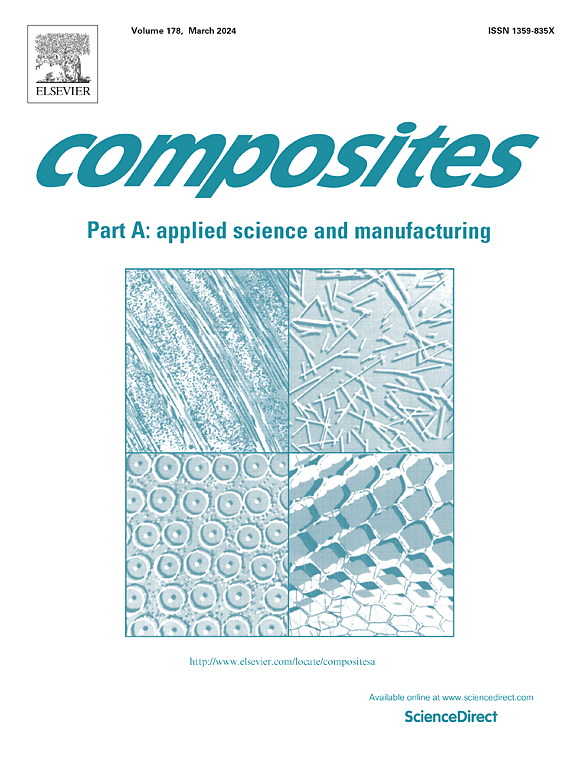用SEM-DIC方法表征Cf/SiC-SiC复合材料应变局部化及裂纹演化
IF 8.1
2区 材料科学
Q1 ENGINEERING, MANUFACTURING
Composites Part A: Applied Science and Manufacturing
Pub Date : 2025-04-10
DOI:10.1016/j.compositesa.2025.108936
引用次数: 0
摘要
在热机械-氧化耦合服役环境中,陶瓷基复合材料(CMC)中由应力引起的微观损伤会影响氧化介质的扩散动力学,加速机械性能的退化。因此,量化微尺度损伤是揭示损伤机理的核心问题。本研究在碳化硅涂层碳纤维增强碳化硅基复合材料(Cf/SiC-SiC)表面制备了低成本、高度均匀的亚微米斑点图案,并利用扫描电子显微镜结合数字图像相关技术准确表征了应变定位和裂纹演变。该研究首次在微观尺度上完整地跟踪并量化了 Cf/SiC-SiC 复合材料的动态损伤演变过程,包括应变定位、界面脱粘、基体开裂、纤维滑移和宏观破坏等关键机制,进一步验证了界面滑移对复合材料增韧的关键作用。实验结果揭示了多裂纹系统的相互作用动力学。进一步的研究发现,SiC 涂层的初始裂纹宽度遵循对数正态分布,而拉伸载荷下裂纹密度的演变则表现出应变阈值效应。涂层的开裂位移(COD)具有 "应力记忆 "效应。这些发现有助于加深对应力和氧化协同效应的理解,并为研究 CMC 的微观和中观损伤行为提供了新的视角。本文章由计算机程序翻译,如有差异,请以英文原文为准。
Characterisation of strain localisation and crack evolution of Cf/SiC-SiC composites by SEM-DIC method
In thermo-mechanical-oxidative coupling service environments, stress-induced microscale damage in ceramic matrix composites (CMCs) governs diffusion kinetics of oxidising media, accelerating degradation of mechanical properties. Therefore, the quantification of microscale damage is a core issue in revealing damage mechanisms. In this study, a low-cost, highly uniform submicron speckle pattern was prepared on the surface of silicon carbide-coated carbon fibre-reinforced silicon carbide matrix (Cf/SiC-SiC) composites and the strain localisation and crack evolution were accurately characterised using scanning electron microscopy combined with digital image correlation. For the first time, this study completely tracked and quantified the dynamic damage evolution process of Cf/SiC-SiC composites at the microscale, including key mechanisms such as strain localisation, interfacial debonding, matrix cracking, fibre slip, and macroscopic failure, further verifying the key contribution of interfacial slip to composite toughening. The experimental results revealed the interaction dynamics of the multicrack system. Further research found that the initial crack widths of the SiC coating follow a log-normal distribution, while the evolution of crack density under tensile load exhibits a strain threshold effect. The crack opening displacement (COD) of the coating has a ‘stress memory’ effect. These findings contribute to deeper understanding of the synergistic effect of stress and oxidation and provide a new perspective for studying the microscale and mesoscale damage behaviour of CMCs.
求助全文
通过发布文献求助,成功后即可免费获取论文全文。
去求助
来源期刊

Composites Part A: Applied Science and Manufacturing
工程技术-材料科学:复合
CiteScore
15.20
自引率
5.70%
发文量
492
审稿时长
30 days
期刊介绍:
Composites Part A: Applied Science and Manufacturing is a comprehensive journal that publishes original research papers, review articles, case studies, short communications, and letters covering various aspects of composite materials science and technology. This includes fibrous and particulate reinforcements in polymeric, metallic, and ceramic matrices, as well as 'natural' composites like wood and biological materials. The journal addresses topics such as properties, design, and manufacture of reinforcing fibers and particles, novel architectures and concepts, multifunctional composites, advancements in fabrication and processing, manufacturing science, process modeling, experimental mechanics, microstructural characterization, interfaces, prediction and measurement of mechanical, physical, and chemical behavior, and performance in service. Additionally, articles on economic and commercial aspects, design, and case studies are welcomed. All submissions undergo rigorous peer review to ensure they contribute significantly and innovatively, maintaining high standards for content and presentation. The editorial team aims to expedite the review process for prompt publication.
 求助内容:
求助内容: 应助结果提醒方式:
应助结果提醒方式:


